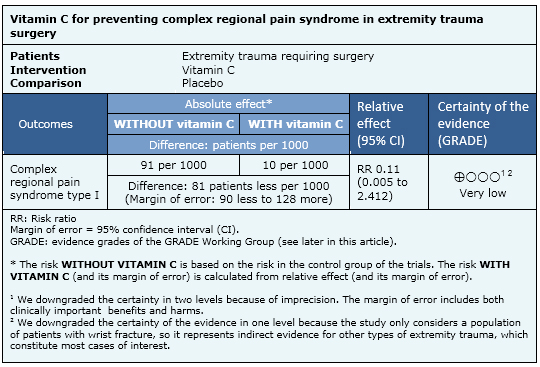Resúmenes Epistemonikos
← vista completaPublicado el 30 de julio de 2015 | http://doi.org/10.5867/medwave.2015.6184
¿Previene la vitamina C la aparición del síndrome de dolor regional complejo en pacientes sometidos a cirugía por trauma de extremidades?
Does vitamin C prevent the occurrence of complex regional pain syndrome in patients with extremity trauma requiring surgery?
Abstract
The complex regional pain syndrome is a neuroinflammatory pathology that affects the central and peripheral nervous system, characterized by disproportional pain in relation to the trauma experimented by the patient. It has been proposed that vitamin C could prevent the development of this syndrome in patients with limb trauma and surgery. Searching in Epistemonikos database, which is maintained by screening 30 databases, we identified two systematic reviews that indentified four primary studies, including one randomized controlled trial. We generated a summary of findings table following the GRADE approach. We concluded it is uncertain whether vitamin C prevents complex regional pain syndrome because the certainty of the evidence is very low.
Problem
Complex regional pain syndrome is a condition that may occur following a traumatism or extremity surgery. It contributes to a longer hospital stay and a slower rehabilitation process. Vitamin C is a safe and low cost medication, whose antioxidant properties might stabilize free radicals that normally damage the lipid membranes and the microcirculation, therefore it has been proposed it could prevent the onset of the complex regional pain syndrome in patients with extremity trauma, especially those that require surgery.
Methods
We used Epistemonikos database, which is maintained by screening more than 30 databases, to identify systematic reviews and their included primary studies. With this information we generated a structured summary using a pre-established format, which includes key messages, a summary of the body of evidence (presented as an evidence matrix in Epistemonikos), meta-analysis of the total of studies in case more than one pertinent study is identified, a summary of findings table following the GRADE approach and a table of other considerations for decision-making.
|
Key messages
|
About the body of evidence for this question
|
What is the evidence. |
We found two systematic reviews [1],[2] including four primary studies reported in six references [3],[4],[5],[6],[7],[8], of which only one correspond to a randomized controlled trial (reported in two references) [6],[7]. This table and the summary in general are based on the latter. |
|
What types of patients were included |
Adults (18 years or more), with a fracture of one or both wrists, under conservative treatment or surgery. All types of wrist fractures were included. The included surgical treatments were closed reduction external fixation (bridging technique), closed reduction and internal fixation (Kapandji) and open reduction and internal fixation. |
|
What types of interventions were included |
The study compared daily doses of 200, 500 and 1500 mg for 50 days starting the day of the injury. The comparison was against placebo. |
|
What types of outcomes were measured |
Incidence of complex regional pain syndrome clinically diagnosed using Veldman criteria, having to fulfill 4 of the 5 following criteria:
|
Summary of findings
The information on the effects of vitamin C for the prevention of complex regional pain syndrome type I is based on one randomised controlled trial including 416 patients with 427 wrist fracture, of which 48 required surgical treatment (only the latter were considered in our analysis).
- It is uncertain whether vitamin C prevents complex regional pain syndrome in patients with extremity trauma that require surgery because the certainty of the evidence is very low.


Other considerations for decision-making
|
To whom this evidence does and does not apply |
|
| About the outcomes included in this summary |
|
| Balance between benefits and risks, and certainty of the evidence |
|
| Resource considerations |
|
|
Differences between this summary and other sources |
|
| Could this evidence change in the future? |
|
How we conducted this summary
Using automated and collaborative means, we compiled all the relevant evidence for the question of interest and we present it as a matrix of evidence.
 Full size
Full size Follow the link to access the interactive version Efficacy of vitamin C for complex regional pain syndrome in extremity surgery
Notes
The upper portion of the matrix of evidence will display a warning of “new evidence” if new systematic reviews are published after the publication of this summary. Even though the project considers the periodical update of these summaries, users are invited to comment in Medwave or to contact the authors through email if they find new evidence and the summary should be updated earlier. After creating an account in Epistemonikos, users will be able to save the matrixes and to receive automated notifications any time new evidence potentially relevant for the question appears.
The details about the methods used to produce these summaries are described here http://dx.doi.org/10.5867/medwave.2014.06.5997.
Epistemonikos foundation is a non-for-profit organization aiming to bring information closer to health decision-makers with technology. Its main development is Epistemonikos database (www.epistemonikos.org).
These summaries follow a rigorous process of internal peer review.
Conflicts of interest
The authors do not have relevant interests to declare.

